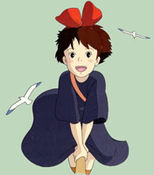Animation
Animation is the illusion of motion created by flashing multiple still images before the viewer. The viewer’s brain assembles the images in sequence to send the message:
- “I see Movement! Run!...or Kill!... or Run! Wait a second, that's not real. HEY!”
Early History[edit | edit source]
The earliest examples of animation are the prehistoric cave paintings of Cantabria, Spain. These simple works required the viewer to blink his eyes really, really fast. Animation from this period recorded scenes of everyday prehistoric life such as men standing around, dogs sleeping, or dead mastodons.
Ancient China[edit | edit source]
By 300 AD in Jin Dynasty, China, animation had reached a level of skill that would not be rivaled by other cultures for another 1,600 years. Animations were stored in massive warehouses throughout the kingdom, with scholars and artists working for years on an individual piece. Sadly, the works were extremely unstable and prone to spontaneous combustion. Hundreds of original masterpieces were lost forever in huge animation warehouse fires. Because of there inherit flammability, animations were also used in fireworks, and still are to this day. The military applications of this were not realized until China’s first contact with the west in 1853, when Commodore Matthew Perry of the US Navy sailed four warships into Beijing harbor.
Muybridge[edit | edit source]
In 1872 Eadweard Muybridge invented a system of capturing multiple photographic stills of walking subjects that could later be played back in sequence. These stills were mounted at even intervals in a cylindrical device called a “Ferris wheel”. A viewer would peer through a small slot and the photos would appear to move. Audiences were so astounded, that Muybridge would often be chased out of town by angry mobs, and was eventually burned as a witch in 1904.
Disney AAF Babycakes <3 <3 <3 :P[edit | edit source]
In 1928 Walt Disney created the iconic character, Mickey Mouse, which he named after the famous Yankees baseball player, Mickey Rourke. His early success lead to the founding of the influential Disney animation studio. The studio was renowned for creating the best animated features possible and for its enlightened business practices. The studio was the first American corporation to institute the 40-hour workweek, offer full health benefits, and provide only Fair Trade snacks in its cafeteria. The studio was also famous for allowing entry level artists creative input on large scale projects. Jane Lopez, an early Disney artist was quoted, “It beats picking avocados.”
Miyazaki[edit | edit source]
Hayao Miyazaki is a small-time director considered by many to be Japan’s Disney. His epic masterpiece, Nausicaä, portrays a plucky adolescent princess trying to stop a war in an ecologically dying world. American animation geeks may also be familiar with his more popular children’s film, My Neighbor Totoro. This film depicts the friendship between a tall, overweight businessman and two plucky adolescent prostitutes with hearts of gold. Many of Miyazaki's films star adolescent girls and explore ecological themes. In fact, Miyazaki is single handedly responsible for creating Japan’s obsession with Asian school girls as well as pushing through the ill-conceived Kyoto Protocol.
Computer Animation[edit | edit source]
The invention of the computer gave animators a new toolset to explore their visions. Modern computer generated images (CGI) are also known as .GIF animations. GIF is an acronym for Gratuitous Imagery Format and can be recognized by clogging up most webpages with little dancing critters and logos. Rendering GIF files requires huge “render farms” and massive processing firepower.
Superior examples of computer animation can be found in the Pixar films Cars and Finding Nemo. These films are created entirely of GIF animation with Adobe ImageReady. Computer generated images are ever so advanced, and is getting more advanced as wii speak. Look at this music video made with the latest computing available.
Video Game Animation[edit | edit source]
The first interactive computer animation was made popular by the 1971 video game Pong. Pong was a complex 2-player quest game involving multiple puzzles and lush environments, based on Sophocles’ Riddle of the Sphinx.
Today, computer games are a giant industry, with programmers and artists working days or even weeks to get a successful game on store shelves.
CARTOONS RULE, THEY DONT PENCIL, NOR DO THEY SHARPEN, THEY RULE!!! <3[edit | edit source]
Saturday morning cartoons were a staple for children growing up in the 60’s, 70’s and 80’s. With the arrival of cable, entire networks became devoted to cartoons and children’s programming. (Cartoon Network, Nickelodeon) The cartoon audience became dispersed; cartoons lost popularity, and, by the year 2000, cartoons went the way of the daguerreotype.
Claymation[edit | edit source]
Is really hard. Claymation is so hard as to be considered impossible with today’s technology. Some theorists believe that claymation may be possible in a nanotech future.
Some "claymaters" have reached some marginal considerable success. They are generally disliked by society.
Animation Timeline[edit | edit source]
- Adobe's introduction of the eased keyframe changed the course of history.
The Animated Dead[edit | edit source]
Unlike traditional cel animation, animating the dead requires the military chemical 2-4-5 Trioxin to be distributed as a fine mist over cemeteries, battlefields, or mass graves with a crop duster or similar device. The resulting zombies are soulless, eating machines, craving the human brain.
Level 3 Clerics can also animate the dead, depending on the number of years at art school. Rhode Island School of Design is the only school in the US that offers a major in animating corpses, quaintly nicknamed the “Undead” after the school’s mascot.




